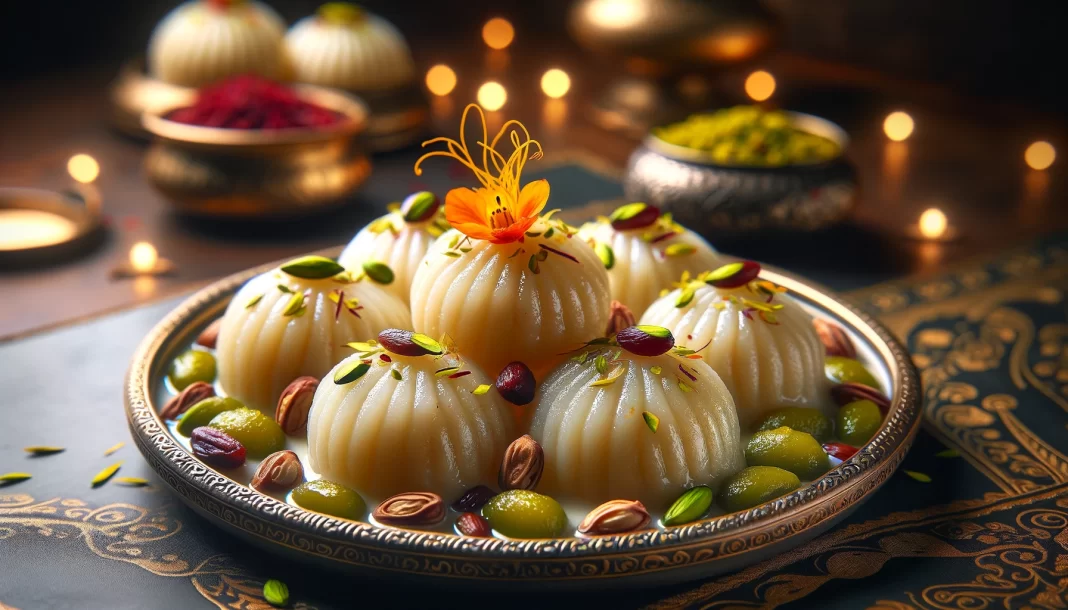If you’re someone with a sweet tooth, there’s a good chance you’ve encountered the wonders of Bengali sweets. But have you ever tried Kheer Kadam? This exotic sweet, also known as Raskadam, is a true indulgence for anyone who loves to explore unique desserts. It’s an intriguing fusion of flavors and textures, where one beloved sweet is enveloped by another. Imagine the rich, creamy sweetness of khoya surrounding the juicy, spongy rasgulla. Intrigued yet? Let’s dive into the delightful world of Kheer Kadam, its origins, and why it deserves a place on your dessert table.
What is Kheer Kadam?
Kheer Kadam is a fascinating Bengali sweet that combines two distinct traditional Indian desserts: rasgulla and khoya. At first glance, it may appear like a simple dumpling, but the real magic lies within. The rasgulla, which is already a popular Bengali sweet made from chhena (freshly made cheese), is stuffed with a rich layer of sweetened khoya (milk solids). This delicious filling is then coated with more khoya, giving it a soft and melt-in-your-mouth texture.
The result? A sweet treat that’s bursting with flavors and textures—a warm, soft, spongy rasgulla nestled inside a smooth and creamy khoya shell. Each bite is an explosion of sweetness that’s not too overpowering, yet perfectly indulgent.
The Origin of Kheer Kadam
Kheer Kadam is a classic example of Bengali culinary innovation. The tradition of creating sweets by enclosing one dessert inside another is a hallmark of Bengali cuisine. In fact, the idea of encasing rasgullas in sweetened khoya came from a desire to elevate the traditional rasgulla into something more luxurious and richer in taste.
Bengal has always been known for its rich and diverse sweet-making culture. Whether it’s sandesh, mishti doi, or the legendary rasgulla, Bengali sweets have found their way into the hearts of people across India and beyond. Kheer Kadam is just another testament to the region’s ability to create delightful, indulgent desserts.
How is Kheer Kadam Made?
The process of making Kheer Kadam involves several steps, each contributing to its distinctive taste and texture. Let’s break down the ingredients and method used to make this mouthwatering sweet.
1. The Rasgulla
The foundation of Kheer Kadam is the rasgulla—a spongy, soft ball made from chhena, soaked in sugary syrup. To make the rasgulla, fresh chhena is kneaded and shaped into small round balls, which are then boiled in a sugar syrup until they become soft and absorb the syrup.
2. Making Khoya
Next, khoya (also known as mawa) is prepared by simmering whole milk until it thickens and reduces to a solid. This sweetened khoya is the key ingredient that makes Kheer Kadam so special. It’s creamy, rich, and has a slightly granular texture, which provides a perfect contrast to the smoothness of the rasgulla.
3. The Assembly
Once the rasgullas and khoya are ready, the next step is assembling the Kheer Kadam. Each rasgulla is carefully stuffed with khoya. Then, the stuffed rasgulla is rolled in more khoya to form a dumpling-like shape. The outer layer of khoya is often garnished with chopped pistachios or almonds to add a touch of elegance.
4. The Final Touch
The final step is letting the Kheer Kadam set for a while, allowing the khoya to firm up around the rasgulla. The result is a sweet dumpling that is both rich and creamy on the inside, and soft and spongy on the outside.
Why is Kheer Kadam So Special?
The reason Kheer Kadam is so loved by many is because it takes two beloved Indian sweets and combines them into one. Here are a few reasons why Kheer Kadam stands out:
- Two Favorites in One: By combining rasgulla and khoya, you get a perfect balance of textures—soft and spongy with creamy and rich.
- Melt-in-the-mouth Goodness: The khoya coating provides a smooth, melt-in-your-mouth experience, while the rasgulla remains slightly chewy, making every bite a treat.
- Visual Appeal: The shape of Kheer Kadam is elegant, often garnished with pistachios or saffron strands, making it a visually appealing sweet that can brighten up any celebration.
- Perfect for Festivals: In Bengali households, Kheer Kadam is often made during festivals like Durga Puja and Diwali. Its rich flavor and texture make it a fitting addition to any festive spread.
Where to Find Kheer Kadam
Kheer Kadam may not be as commonly found as other Bengali sweets, but it is a delicacy available in select sweet shops across Bengal. If you’re lucky enough to visit Kolkata, be sure to look for it in traditional Bengali sweet shops like Balaram Mullick and Radharaman Mullick. Many online sweet retailers also offer Kheer Kadam for delivery, making it easy for people across the country to enjoy this delicacy.
Kheer Kadam vs. Rasgulla
While both rasgulla and Kheer Kadam originate from Bengal, there are distinct differences between the two. The primary difference lies in the texture and richness of Kheer Kadam. While rasgullas are light and spongy, Kheer Kadam is a far more indulgent dessert with the added richness of khoya.
Kheer Kadam also has a more complex flavor profile due to the khoya filling, which makes it a luxurious twist on the humble rasgulla. It’s perfect for those who want to enjoy the iconic rasgulla in a more sophisticated and extravagant form.
Conclusion
In the world of Bengali sweets, Kheer Kadam is a true gem. It’s a perfect example of how innovation and tradition can come together to create something unique and extraordinary. If you’re a fan of rasgullas or khoya, then Kheer Kadam is a must-try. Whether you’re celebrating a festival or just looking to indulge your sweet tooth, this Bengali dessert promises to deliver a delightful experience. So, next time you’re craving something sweet, try Kheer Kadam and savor the delicious layers of Bengali tradition wrapped in a single bite.



